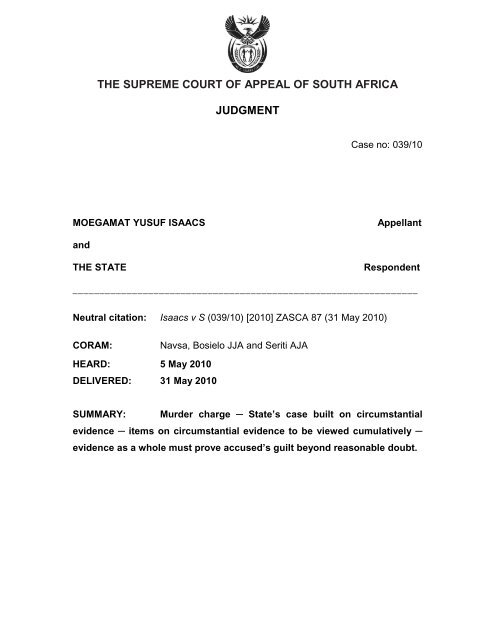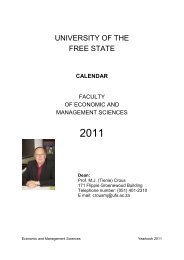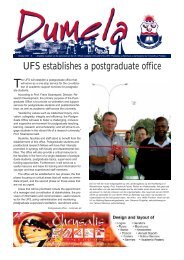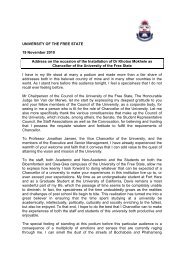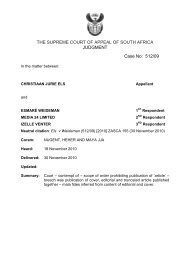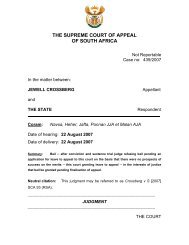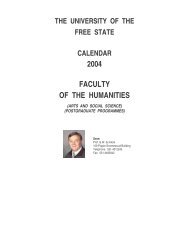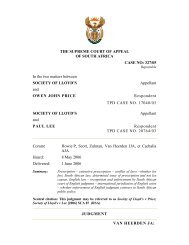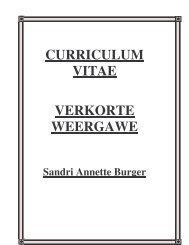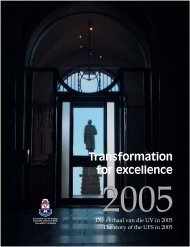THE SUPREME COURT OF APPEAL OF SOUTH AFRICA JUDGMENT
THE SUPREME COURT OF APPEAL OF SOUTH AFRICA JUDGMENT
THE SUPREME COURT OF APPEAL OF SOUTH AFRICA JUDGMENT
Create successful ePaper yourself
Turn your PDF publications into a flip-book with our unique Google optimized e-Paper software.
<strong>THE</strong> <strong>SUPREME</strong> <strong>COURT</strong> <strong>OF</strong> <strong>APPEAL</strong> <strong>OF</strong> <strong>SOUTH</strong> <strong>AFRICA</strong><strong>JUDGMENT</strong>Case no: 039/10MOEGAMAT YUSUF ISAACSAppellantand<strong>THE</strong> STATERespondent________________________________________________________________Neutral citation: Isaacs v S (039/10) [2010] ZASCA 87 (31 May 2010)CORAM:Navsa, Bosielo JJA and Seriti AJAHEARD: 5 May 2010DELIVERED: 31 May 2010SUMMARY: Murder charge ─ State’s case built on circumstantialevidence ─ items on circumstantial evidence to be viewed cumulatively ─evidence as a whole must prove accused’s guilt beyond reasonable doubt.
2______________________________________________________________ORDER______________________________________________________________On appeal from:court of first instance).The appeal is dismissed.Western Cape High Court, Cape Town (Ndita J sitting as______________________________________________________________<strong>JUDGMENT</strong>______________________________________________________________NAVSA JA (Bosielo JA and Seriti AJA concurring)[1] On Sunday 6 th July 2003, Priscilla and Michael Heneke, the dotingmaternal grandparents of eight year-old Sasha Leigh Crook, watched theirgranddaughter play in and around their house at 47 Adrian Road, Ottery, CapeTown. They could not have imagined that later that day she would disappear andthat eight days thereafter, during the early hours of Monday 14 July 2003, herbody would be discovered in the vicinity of a rubbish dump in Muizenberg.[2] The appellant, Moegamat Yusuf Isaacs, was convicted in the Cape HighCourt (Ndita AJ, sitting with two assessors) of Sasha Leigh’s murder. Theconviction was based on circumstantial evidence and on statements he hadallegedly made to his mother, Mrs Fatima Isaacs, in the presence of police. Thequestion in this appeal, which is before us with the leave of this court, is whetherthe State had proved beyond reasonable doubt that the appellant had murderedSasha Leigh.[3] At material times the appellant, together with his wife and mother, residedright next door to Sasha Leigh’s grandparents, at 45 Adrian Road, Ottery. He isthe last known person to have seen her alive. It is common cause that some timeafter lunch on that fateful Sunday, Sasha Leigh had gone over to the front of the
3appellant’s house, after she had spoken to him over the low fence separating thetwo homes, and that she had then followed him through a gate into the backyard.[4] According to the appellant, he had been under the influence of dagga and,although he had seen Sasha Leigh enter the yard behind him, he immediatelywent to sit at a table in the yard where he rested his head and had dozed off. Hetestified that he had no idea of what had happened to her thereafter. Theappellant testified further that his mother’s prospective tenant had come to dropoff a refrigerator at the flat at the back of their house and that he had interactedwith this person at about the time that Sasha Leigh had gone missing and thatthis had occurred before 14h00. According to the appellant he had departed thescene before 14h00 to be at a friend’s house to watch a television moviescheduled to start at 14h00. This part of his testimony was directed at showingthat he could not have murdered Sasha Leigh. Put differently, there had been noopportunity for him to have committed the foul deed - at material times he hadbeen in the company of others. As will become apparent it was an alibi defenceof sorts.[5] From the time that she had entered the yard at house no 45, Sasha Leighwas not seen in public again until the discovery of her body on 14 July 2003 byMr Daniel Geduld, an employee of a private security firm who was patrolling theveld in an area known as Pelican Heights in Muizenberg. By then dogs had tornat the face and neck of the body lying in the vicinity of a rubbish dump and near asports field.[6] As will be seen in due course, the degree of decomposition of the body isrelevant, as is a tiny fragment of a pressed wooden board having the appearanceof a marble finish (of the kind found on kitchen surfaces), that the police allegethey had found between the clothes that covered Sasha Leigh’s body. Theassessment of objective evidence is of crucial importance to a determination ofthe appellant’s guilt.
4Sunday 6 July 2003[7] It is necessary to attempt to get as full a picture as possible of what hadoccurred on the Sunday on which Sasha Leigh had disappeared. In doing so, theevidence of neighbours and the appellant’s own evidence concerning hismovements during that day will be dealt with.[8] Sasha Leigh had spent the week preceding Sunday 6 July 2003, whichwas part of her school holidays, at her grandparents’ home. It appears that hermother regularly allowed her to spend time with them. Thus, she was not astranger in the neighbourhood. It is common cause that Sasha Leigh often playedin the neighbourhood and had befriended, amongst others, the appellant’s twoyear-old niece Ashiema, who at one stage lived at her grandmother’s home, nextdoor.[9] On that Sunday morning, upon her return from Church with hergrandmother, Sasha Leigh played in and around the house. Her grandmotherprepared lunch whilst her grandfather watched television. They saw herintermittently. She had repeatedly remonstrated with her grandmother becauseshe was unhappy that the latter was preparing steak, vegetables and roastpotatoes for lunch. She extracted an undertaking from her grandmother that herpreferred meal of roast chicken would be on the menu for supper that night.Sasha Leigh and her grandparents were all conscious of time as they were allscheduled to attend a party at 15h00.[10] After lunch, in anticipation of attending the party, Sasha Leigh dressedherself in the tracksuit in which her body was later discovered. According to hergrandmother the first time she discovered that Sasha Leigh was missing wasafter 14h00. That time largely accords with what neighbours testified was thetime they saw Sasha Leigh enter the premises next door.
5[11] Sasha Leigh’s grandmother immediately went searching for hergranddaughter in the neighbourhood. Her first port of call was the house nextdoor, house no 45. The windows and the front door were closed. It appears thatno-one was home. She then went to house no 43 and was told that Sasha Leighwas not there. She looked at the house directly across the street, where MrsAntoinette Jacobs and her three daughters were having tea on the front porch.An enquiry directed at them elicited the answer that Sasha Leigh had been seena short while earlier at the appellant’s home and that she had entered thebackyard through a side gate.[12] Sasha Leigh’s grandmother went back to house no 45 and this timeapproached the side-gate leading to the back yard. The gate was made of steeland one could not see through it. She called out her granddaughter’s name andthe appellant came to the gate. He told her that Sasha Leigh was not there.[13] When Sasha Leigh’s grandmother testified it was never put to her that theappellant had told her that Sasha Leigh had been there earlier. In his evidencein-chief the appellant did not testify that he had done so. It was only later, duringcross-examination that he said he had told her that Sasha Leigh had been thereearlier. That part of his evidence was in response to the prosecutor putting to theappellant that it could reasonably be expected of him to have told Sasha Leigh’sgrandmother about her earlier presence in the yard. It was clearly an afterthoughtand was brought about by pressure from the cross-examiner.[14] A continued frantic search by Sasha Leigh’s grandparents, in theimmediate neighbourhood and beyond, during the remainder of that Sunday,proved fruitless.[15] Ms Martina Jacobs, who, after lunch on that Sunday, had been drinkingtea on the porch with her mother and two siblings saw the appellant and Sasha
6Leigh converse over the fence and then saw the latter cross over to the front ofthe appellant’s house. Ms Jacobs saw Sasha Leigh follow the appellant towardsthe backyard. She did not see Sasha Leigh re-emerge. She was the one who hadtold Sasha Leigh’s grandmother that she had seen Sasha Leigh at house no 45.[16] According to Ms Jacobs, a short while after Sasha Leigh’s grandmotherhad left house no 45, the appellant emerged and stood at the front of the house,wearing a white t-shirt. He went back into the yard, came out a short while laterwearing a jersey and proceeded to walk down the road.[17] During the time that she and the other members of her family had been onthe front porch Ms Jacobs did not see a bakkie arrive at the appellant’s house tooffload a refrigerator. She, her mother and two sisters remained on the porchuntil approximately 15h00. Although Ms Jacobs conceded that she might havemissed seeing the bakkie, she was adamant that she would have noticed arefrigerator being offloaded.[18] Mrs Antoinette Jacobs, who had been standing on the front porch with herdaughters that Sunday afternoon, had noticed that when the appellant left hishouse that afternoon, after talking to Sasha Leigh’s grandmother, he had failed togreet as he usually does. The last time Mrs Jacobs saw Sasha Leigh was whenthe latter was walking behind the appellant on the front porch of house no 45.She didn’t see a white bakkie offloading a refrigerator during the time she was onthe front porch.[19] The appellant, who at the time of the incident in question was 26 yearsold, testified that he had a drug problem and that he owed drug dealers a largesum of money and had been threatened by them. The threats were directed athis family. This part of the appellant’s evidence was directed at showing thatthere was a possibility that Sasha Leigh had been snatched by the drug dealers
7in the mistaken belief that she was the appellant’s two year-old niece Ashima.This is an aspect that will receive further attention later in this judgment.[20] At the time of Sasha Leigh’s disappearance the appellant had been livingwith his mother and wife in the main house. They had recently moved from theflat at the back of the yard. The appellant’s mother’s prospective tenant had beengiven the keys to the flat. According to the appellant he did not himself have keysto either the flat or the main house. His wife and mother kept a set of keys to themain house.[21] On that disastrous Sunday the appellant awoke at 11h30. His wife hadalready gone to work and his mother was busy in the kitchen. The appellant wentover to his friend Kashief’s house. Kashief lived six houses away from him, in thesame street. The appellant and Kashief smoked dagga at the latter’s house. Atapproximately 13h00 the appellant went home for lunch. On his way home hehad seen the Jacobs family on the front porch of their home. Upon his arrival hediscovered that his wife and mother were not home and that he had been lockedout. He sat in the driveway awaiting his mother’s return.[22] The appellant testified that whilst he sat in the driveway Sasha Leighapproached and spoke to him over the fence. She told him that she was gettingready to go to a party and that she was waiting for her grandmother to getdressed. Sasha Leigh then came over to their property and asked him if Ashiemawas there. He told her that Ashiema and her mother had moved and no longerlived there. He got up and walked into the backyard and she ‘probably walkedbehind me and played into the yard’.[23] According to the appellant he then took off his top and went to sit at atable in the yard. He laid his head on the table and, probably because he hadbeen under the influence of dagga, dozed off. Suddenly, he heard Sasha Leigh’sgrandmother call out her name. He got up, went to the gate and, upon enquiry
8from her, first looked briefly into the yard and then told her that Sasha Leigh wasnot there. He suggested that she look for Sasha Leigh at another neighbour’shouse. He went back into the yard and five minutes later the new tenant,accompanied by another person, arrived with a bakkie to offload a refrigerator.He spoke briefly to the new tenant who departed shortly thereafter.[24] After the tenant’s departure the appellant put his top back on. Tired ofwaiting for his mother, he left and went back to Kashief’s place. The appellanttold Kashief he had not had lunch, whereupon the latter sent two of his friends tobuy food. The appellant was adamant that all this had occurred before 14h00,because the television movie scheduled to begin at that time had not yet started.They watched television until his wife hooted outside. He accompanied his wife tothe Muizenberg flea-market where they had lunch.[25] The extent to which the dagga affected the appellant’s awareness and thequality of his evidence are aspects that will be dealt with later in this judgment.The post-mortem findings which bear on what might have happened to SashaLeigh on that Sunday will also be referred to in some detail later on.Subsequent events[26] Sasha Leigh’s disappearance and the discovery of her body were widelypublicised. First there had been pressure on the police to find her and then to findher murderer.[27] When the police arrived at the scene where Sasha Leigh’s body wasdiscovered they found certain items, which they collected as exhibits for forensictesting and which were referred to in evidence at the trial. They obtained the tinyfragment of a pressed wooden board, of the kind used in kitchen tops, andreferred to earlier in this judgment, in-between the items of clothing that coveredSasha Leigh’s body. In the vicinity of Sasha Leigh’s body they found two white
9bags of the kind used by builders. In one of the white bags they found traces ofSasha Leigh’s DNA. The police found similar bags at the appellant’s houseduring a search conducted there. According to the appellant his late father, whohad been a builder, had used such bags. It is common cause that such bags arefreely available commercially. The bags found at the scene could not be directlylinked to the appellant.[28] It is necessary to record that the place at which Sasha Leigh’s body wasfound is frequently used by members of the public to dump refuse. A set ofmotor vehicle tyre tracks leading to the body was seen by the police. Theydecided to take a mould of the tyre tracks for possible linkage to a motor vehiclethat might have been used to transport the body. The police did not make mouldsof other tyre tracks in the vicinity, which are clearly visible from photographstaken by the police photographer.[29] During the afternoon of 14 July 2003, the day on which Sasha Leigh’sbody was discovered in Muizenberg, the police sought and obtained a searchwarrant entitling them to search the appellant’s house. The police forensic teamassisted in obtaining exhibits from the house for possible use in theirinvestigations. They conducted the search whilst the appellant, his wife and hismother were home. A garden shed with two entrances, located in the backyard ofthe appellant’s house was searched and the police found a wooden board whichhad a marble finish and which could possibly be linked to the fragment found onSasha Leigh.[30] On the same day on which the police had conducted the first search theyconfiscated the appellant’s wife’s motor vehicle and decided to arrest him. Hewas taken into custody and transported to the Parow Police Station.[31] Two days later, on 16 July 2003, the police obtained a second searchwarrant to search the premises where the appellant lived. This time they
10conducted a search of the garage on the premises, which they had omitted to doon the first occasion. The appellant’s mother was home when the second searchwas conducted. This time, however, they took as exhibits swabs and filter papersamples of what appeared to be blood they had discovered on a plastic shoppingbag in a paint container in the garage. Part of a white T-shirt was found under aplastic bag in the paint container. The police also found a piece of pink clothunder a plastic bag in the paint container. Other objects were also seized by thepolice. On the same day they confiscated a second motor vehicle belonging tothe appellant’s mother to enable them to conduct forensic tests.[32] After Mrs Fatima Isaacs, the appellant’s mother, had agreed to release thecar to the police she accompanied Captain Pragasan Naidoo to the Serious andViolent Crimes Unit’s offices at Bishop Lavis. Mrs Isaacs intended to visit theappellant and Captain Naidoo required a statement from her in relation to the useof her motor vehicle. According to Captain Naidoo, upon their arrival at BishopLavis they passed the office of the investigating officer, Inspector Anna Cilliers.When Mrs Isaacs saw the appellant she immediately went to him. Mrs Isaacs andher son both burst into tears and hugged each other. Captain Naidoo testifiedthat Mrs Isaacs had asked the appellant whether he had killed Sasha Leigh andhe had responded in the affirmative. She asked him how he had done it and hereplied: ‘I choked her’. Inspector Cilliers confirmed this aspect of CaptainNaidoo’s evidence and also that he had instructed her to take notes of what hadbeen said.[33] At the time of the alleged exchange, Director Joseph Makhura, a memberof SAPS, was also stationed at the Serious and Violent Crime Unit in BishopLavis. He too, confirmed that he had overheard the exchange between MrsIsaacs and the appellant referred to above.[34] According to Captain Naidoo he later took Mrs Isaacs to his office andasked her if she was willing to make a statement about the exchange between
11her and the appellant and she agreed. He proceeded to write the statement andread it out to her. She hesitated for a minute before signing it. The statement waswritten in English and was produced at the trial.[35] The appellant and his mother, whilst admitting that they had cried andcomforted each other, both denied the exchange in question. Mrs Isaacs claimedthat she was illiterate. She testified that she could understand some English butwas not proficient in that language. She testified that as far as she wasconcerned, the written statement she had signed related only to the use of hermotor vehicle by the appellant[36] The appellant’s former wife (they were divorced after his arrest),Ms Fagmeda Isaacs, testified and supported his version of events of herinteraction with him on the Sunday on which Sasha Leigh had disappeared. Sheconfirmed that he had worn a white t-shirt on that day. She testified further thathe did not have keys to either the flat or the main house. Ms Isaacs was aware ofthe appellant’s drug problem.[37] Mr Ashaan Williams, the prospective tenant for the flat at the back of theappellant’s house, testified in support of the appellant’s case. He confirmed thathe had delivered a refrigerator at the appellant’s home on a Sunday but could notrecall the date. He testified that he had been accompanied by two other personsand that he had encountered the appellant in the yard leading to the flat. MrWilliams could initially not recall the type or colour of the bakkie which he hadused to deliver the refrigerator. However, after an adjournment during the trialthose particulars came to him. According to Mr Williams, he had delivered therefrigerator between 14h00 and 15h00 that Sunday. He was adamant about this.Importantly, he initially testified that Mrs Fatima Isaacs had written out his rentalreceipt. When it was put to him that she had claimed to be illiterate he respondedby stating he had not meant that she had written it herself. He sought to excusehis initial answer by stating that he had misunderstood the question. Under cross-
12examination, Mr Williams stated that he had not wanted to be in court and wasthere only because he had been subpoenaed. He went on to state the following:‘I didn’t want to get involved, because it’s been such a while back that I don’t remembereverything as in detail.’This is contrary to an earlier part of his evidence that he was testifying becausehe had a contribution to make.The post-mortem report, the testimony of the pathologist and other expertevidence[38] Dr Denise Lourens conducted the post-mortem examination on SashaLeigh. She testified that the body was in an early state of decomposition. Shefound a penetrating incised wound which indicated a stab wound caused by aweapon like a knife. This wound was situated over the right anterior lower neck.The right common carotid artery was completely transected with the well definedclear lines or edges, in keeping with a stab wound or a cut.[39] According to Dr Lourens, the index of suspicion of throttling orstrangulation is very high but, because the flesh in the region of the neck hadbeen eaten away by animals, probably dogs, potential evidence in this regard inthat area of the body had been lost. However, there was evidence of throttling orstrangulation in the form of petechial haemorrhages in other parts of SashaLeigh’s body, particularly in the heart and lungs. Patechial haemorrhages areseen most frequently where there is anoxic damage, due to a lack of oxygen.[40] Another important post-mortem evidential feature is that Sasha Leigh’sbody showed scalp bruising. She had sustained two types of brain haemorrhagesindicating blunt trauma to the head. Significantly, she was alive when it wasinflicted. There would have been no sign of any haemorrhage had she alreadybeen dead before the blunt trauma to the head.
13[41] Dr Lourens, in dealing with her estimation of the time of death, madeseveral points. First, she dealt with traces of food found in Sasha Leigh’sstomach. She took into account that Sasha Leigh had consumed steak andvegetables for lunch. Had Sasha Leigh been killed immediately after herdisappearance it could be expected that one would see remnants of her lastmeal, particularly of the steak. Red meat like steak would show individual fibresthat would be easily identifiable. According to Dr Lourens one could expect suchtraces up to four hours after the meal. No such traces were found in SashaLeigh’s stomach.[42] In relation to decomposition of the body and its significance, as far as timeof death is concerned, Dr Lourens had the following important comments:(i) Considering the flaccidity and body temperature alone, the indications arethat Sasha Leigh had been dead for at least 36 hours;(ii) However, the temperature to which the body was exposed and theconditions under which it was kept are very important features. Airflow,open windows and general exposure to the elements are all relevantfactors. If, for example, she had been kept in a freezer, that fact alonewould impact on an accurate assessment of the time of death.[43] In Dr Lourens’ view, the lack of insect activity on the body indicated thatSasha Leigh had been kept in a hermetically sealed place for a period of timebefore being left in the field and could have been kept in a freezer. There hadbeen testimony about a freezer in the appellant’s house.[44] Captain Frans Maritz, a ballistics expert employed by SAPS, testified insupport of the State’s case. At the commencement of Captain Maritz’s evidence,counsel representing the appellant readily admitted his expertise. Captain Maritztestified convincingly that the tests he had conducted proved that the fragmentfound on Sasha Leigh matched the board that had been found in the shed behindthe appellant’s house. The tests he had conducted showed that it had broken off
14from the board. It is uncontested that the fragment matches the mock-marblesurface of the wooden board in appearance and colour. In heads of argumentfiled in this court, by the appellant’s counsel’s predecessor, the admissionconcerning Captain Maritz’s expertise was sought to be withdrawn. Theappellant’s present counsel rightly did not persist in this submission.Developments during the trial and admissions made in terms of s 220 of the Act[45] At the commencement of the trial appellant’s counsel said the following onhis behalf:‘To a large extent he chooses to exercise his right of remaining silent at this stage, but isprepared to give a short explanation through me of his defence to the charges. Inasmuch as he ischarged with on 6 July 2003 having committed the offences, his defence will be that of an alibi.. . .The accused’s defence will be . . . that at the times when he is alleged on that day to have insome way abducted or murdered the deceased, he was with a friend of his one Kashief from twoo’clock in the afternoon.We will also seek to show that if a murder of the young lady in question took place in the manneralleged by the State, we seek to show that it is not possible that that could have happened.’[46] When the first witness, Ms Priscilla Heneke, was cross-examined thefollowing was put to her by appellant’s counsel:‘[T]he first thing that I must put to you is that the accused doesn’t remember perfectly what washappening or what happened on that particular afternoon, because he had partaken of dagga.’[47] As stated above, at one stage during the trial, it was suggested that drugdealers to whom the appellant owed money might have snatched Sasha Leigh,mistaking her for the appellant’s two year-old niece, Ashiema. There weretentative suggestions, during the cross-examination of some members of theSAPS that they had conspired to build a case against the appellant. It was builton speculation and suggestion without any evidential foundation.
15[48] A few days into the trial the appellant made certain admissions in terms ofs 220 of the Criminal Procedure Act 51 of 1977 (the CPA) . The most importantare as follows:(i) DNA testing proved that the pink cloth found in the paint container in theappellant’s garage had traces of Sasha Leigh’s genetic material.(ii) A swab and a filter paper that had been applied to what appeared to beblood on the plastic Pick ‘n Pay bag found in the paint container were tested andsimilarly proved to have traces of Sasha Leigh’s genetic material.(iii) A portion of the white t-shirt found in the paint container and which alsoappeared to have blood on it, was also found by DNA testing to have traces ofSasha Leigh’s genetic material.[49] It is necessary to record that neither the appellant’s mother’s car nor hiswife’s could be positively linked to the tyre tracks leading up to Sasha Leigh’sbody.[50] Even though there were suggestions of a police conspiracy to implicatethe appellant neither he nor any other member of his family expressly disavowedany knowledge of the paint container and its contents. Put differently, none ofthem, at any stage, protested that the container or its contents were foreignitems, unknown to them. It was not contested that traces of paint evident in thecontainer were of a similar colour to the outer wall of the appellant’s house.Conclusions[51] In addition to facing a murder charge the appellant had also been chargedwith the rape of Sasha Leigh. He was rightly acquitted, in terms of s 174 of theCPA, on the latter charge. In relation to the count of murder, the court belowcarefully considered the contact between the appellant and Sasha Leigh on theday of her disappearance, the forensic evidence and the alleged exchangebetween him and his mother.
16[52] The court below, having regard to Dr Lourens’ evidence, took the view thatthe time frame during which Sasha Leigh disappeared on that Sunday was lesscrucial than suggested on behalf of the appellant.[53] Ndita J, in the judgment of the court below, rightly took into account that itwas only after several key witnesses had testified that the appellant revealed thatSasha Leigh had followed him into the backyard. As pointed out above this wasonly done during a late stage under cross-examination.[54] It is correct, as noted by the court below, that in a police bag containingthe fragment of the chipped board referred to earlier, there was an additionalpiece which could not be conclusively accounted for. This, however, does notdetract from the fact that the crucial fragment in question was undoubtedlyproved to have been taken off Sasha Leigh’s clothes and linked to the boardfound in the shed at the appellant’s house.[55] The DNA testing and the results referred to in para 48 above were alsotaken into account by the court below.[56] In dealing with the statements allegedly made by the appellant to hismother, the court below had regard to the quality of the testimony of the threemembers of the SAPS referred to above. It also had regard to thecontemporaneous note made by Inspector Cilliers on the instruction of CaptainNaidoo and which, in relation to Sasha Leigh’s entry into the backyard, read asfollows:‘Ek het haar laat kom.’This, according to the State, is what was said before the appellant had told hismother that he had strangled Sasha Leigh.
17[57] The court below found Inspector Cilliers a credible witness and, in myview, there is no basis to quarrel with that conclusion.[58] The court below had regard to the fact that Inspector Stoffels, a policemanwho, although he was not present during the alleged exchange between theappellant and his mother, testified that he had seen the two of them around thattime and that neither had been emotional as testified to by his colleagues orindeed by the appellant himself and his mother. The court rejected InspectorStoffels’ evidence but found the evidence of his three colleagues to beacceptable.[59] Whilst Director Makhura was in my view, a contradictory and unimpressivewitness, I am unable to conclude that the court below was wrong in itsconclusions concerning the quality of the evidence of Captain Naidoo andInspector Cilliers. In contradistinction, the court below rightly found the evidenceof Mrs Fatima Isaacs unsatisfactory in material respects. Like any mother, shewas protective of her child. It is true, as noted by the court below, that her claimof illiteracy was dealt a blow by the evidence of Mr Ashaan Williams, who initiallytestified that she had written out a receipt, which evidence he laterunconvincingly, sought to retract. It is also evident that although she assertedthat she did not really understand English she repeatedly lapsed into thatlanguage when questioned, without any ostensible difficulty.[60] In my view, the court below correctly found the appellant an unimpressivewitness. He was evasive and contradictory. The appellant’s counsel’s warning tothe very first witness that his client’s memory was hampered by the fact that hehad been under the influence of dagga at the time of Sasha Leigh’sdisappearance, was contradicted by the detailed nature of his evidence. Onewould not only expect his memory to have been affected put his perceptivepowers at material times as well. He testified that he knew what time he had leftKashief’s house on the first occasion on Sunday 6 July 2003 because of the time
18indicator on the latter’s video machine. His explanation that he had no properrecall of what had occurred until his detention and that during the time ofdetention his memory cleared and improved is unadulterated nonsense. A furthernegative feature of the appellant’s evidence flows from his responses undercross-examination when he was questioned about time frames on the Sunday inquestion. A reading of the questions and answers will reveal that he attempted totailor his answers to evidence adduced by the State and that he was not relyingon his memory but was resorting to reconstruction. The appellant’s case mutatedduring the trial, from the suggestion that drug dealers might have beenresponsible for Sasha Leigh’s disappearance to the suggestion of a policeconspiracy. The court below pointed out that the disclosure that Sasha Leigh hadfollowed him into the yard came very late during the trial. The disclosure itselfevolved from being speculative to being positive.[61] Courts should always consider the cumulative effect of items ofcircumstantial evidence. In Schwikkard and Van der Merwe Principles ofEvidence 3 ed (2002) p 537-538 the learned authors point out that this approachcan also be put as follows: The state must satisfy the court, not that eachseparate item of evidence is inconsistent with the innocence of the accused, butonly that the evidence taken as a whole is beyond a reasonable doubtinconsistent with such innocence.[62] See also in this regard S v Ntsele 1998 (2) SACR 178 (SCA) at 182D-Fwhere the following appears:‘Ons reg vereis insgelyks nie dat ‘n hof slegs op absolute sekerheid sal handel nie, maar wel opgeregverdigde en redelike oortuigings ─ niks meer en niks minder nie (S v Reddy and Others1996 (2) SASV 1 (A) op 9d-e). Voorts, wanneer ‘n hof met omstandigheidsgetuienis werk, soos indie onderhawige geval, moet die hof nie elke brokkie getuienis afsonderlik betrag om te besluithoeveel gewig daaraan geheg moet word nie. Dit is die kumulatiewe indruk wat al die brokkiestesame het wat oorweeg moet word om te besluit of die aangeklaagde se skuld bo redelike twyfelbewys is (R v De Villiers 1944 AD 493 op 508-9). Dit is inderdaad wat die Verhoorhof in hierdiegeval gedoen het.’
19[63] In the oft cited case of R v Blom 1939 AD 188, this court set out twocardinal rules in relation to inferential reasoning. The first is that the inferencesought to be drawn must be consistent with all the proved facts. The second isthat the proved facts should be such that they exclude every reasonableinference save the one sought to de drawn.[64] Following the approach set out in the authorities that appear above andconsidering the totality of the evidence one is driven to the conclusion that thecourt below was correct in finding that the appellant was guilty of Sasha Leigh’smurder. What follows are in my view the material parts of the evidence viewedcumulatively, that compel the conclusion that the court below cannot be faulted:• the appellant was the last known person to see Sasha Leigh alive.• it is undisputed that Sasha Leigh had followed the appellant into thebackyard.• when Sasha Leigh’s grandmother enquired whether she was there theappellant had not offered to look to see if indeed she was still in the yard.• the fragment of wood found on Sasha Leigh’s clothes and the perfectmatch with the wooden board found in the shed in the appellant’sbackyard point an accusing finger at the appellant.• the items found in the paint container in the garage are similarly damning,particularly when one takes into account that the appellant had notdisclaimed any of the items or the container.• the statements made by the appellant to his mother, that were correctlyadmitted and accepted by the court below, viewed contextually amount toa confession, 1 and are consistent with the evidence of the pathologist andwith the evidence of the Jacobs family that Sasha Leigh appeared to have1 The challenge to the statements allegedly spontaneously made, were not in relation to theiradmissibility, but rather that they had not been made at all. They were made by the appellant notto the police but to his mother in their presence. For a discussion on whether or not a statementamounts to a confession see D T Zeffert, A P Paizes, A St Q Skeen The South African Law ofEvidence (2003) pp 471-474. In the present case the distinction between admissions andconfessions is not important.
20followed the appellant into the yard. The recorded statement by InspectorCilliers reflecting an invitation by the appellant to Sasha Leigh to enter theyard is consistent with that evidence. The confession is made all the morereliable thereby.• had Sasha Leigh re-emerged from the appellants backyard, members ofthe Jacobs family would have been in the best position to see it. None ofthem saw her re-emerge.• the suggested conspiracy against the appellant by the police is ludicrous.It would mean that the police, in anticipation of the discovery of the body,would have had to plant the wooden fragment which they would have hadto acquire from the shed behind the appellant’s house by stealth. Inaddition, they would have had to plant the items in the container in thegarage and plant Sasha Leigh’s DNA material on them. The investigatingofficer, Captain Naidoo, the forensic team and possibly the pathologistwould have had to be part of such a conspiracy. It is so far fetched so asto be rejected out of hand.• The unsatisfactory nature of the appellant’s evidence completes themosaic.[65] It is true that there are some pieces of the puzzle of the precise nature ofSasha Leigh’s death that will always be missing. However, in my view, in the lightof all of the factors set out above it is safe to conclude that the appellant wasresponsible for her death. In my view, the state proved beyond reasonable doubtthat the appellant murdered Sasha Leigh and the court below correctly convictedhim.[66] One further aspect remains. Counsel for the State was constrained toadmit that the police investigation, particularly in relation to the collection andpreservation of evidence, was flawed. Even though the search warrant in respectof the first search had a time limit one would still have expected to have includeda search of the garage. Whilst the pressures under which the police operate are
21appreciated it is nevertheless necessary to warn against sloppy investigation.Victims and accused persons deserve better.[67] For all the reasons set out above, the following order is made:The appeal is dismissed._________________M S NAVSAJUDGE <strong>OF</strong> <strong>APPEAL</strong>
22APPEARANCES:For Appellant:C StamperInstructed byD A J Uijs SC Cape TownFor Respondent:C van der VijverInstructed byThe Director of Public Prosecutions Cape TownThe Director of Public Prosecutions Bloemfontein


